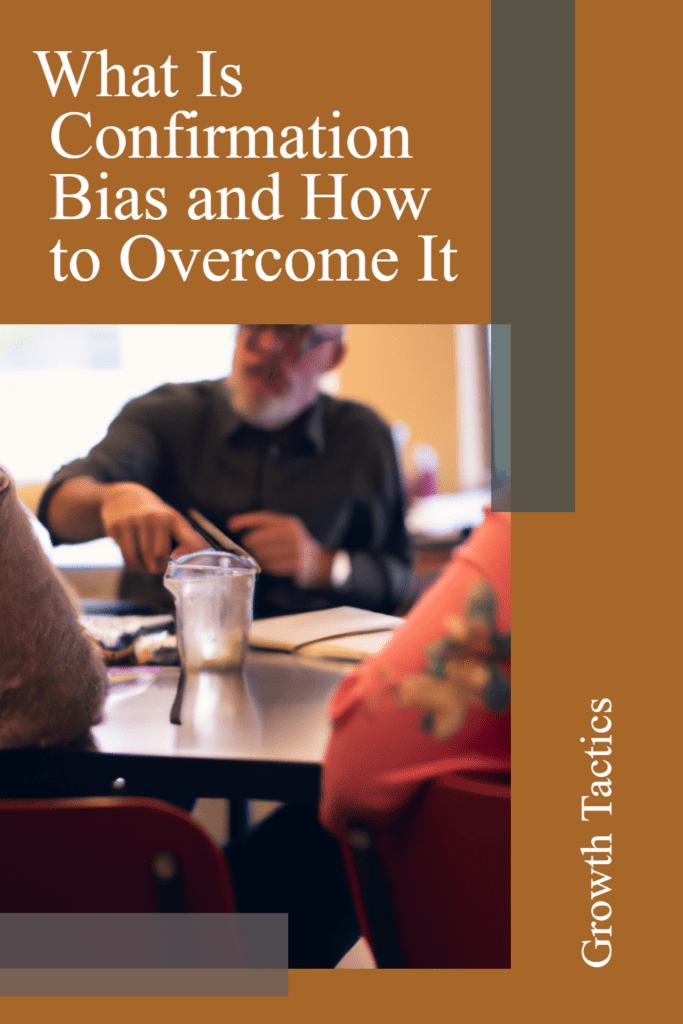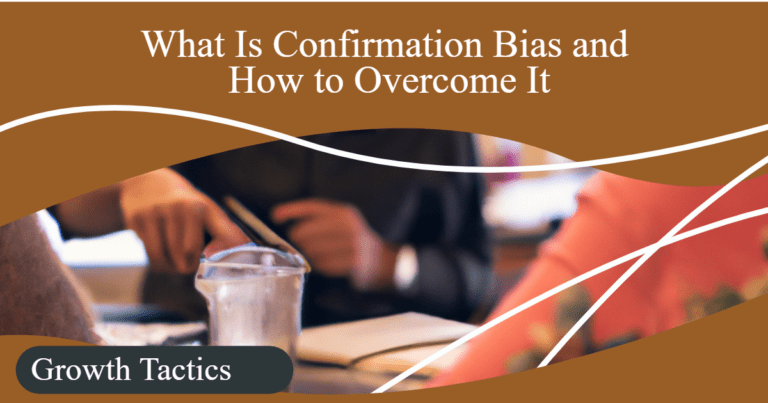Have you ever found yourself so convinced of your own ideas that you ignore any evidence to the contrary? That’s confirmation bias at work. In this article, we’ll explore what confirmation bias is, how it affects our decision-making, and most importantly, how to overcome it.
Jump To Section
What is Confirmation Bias?
Confirmation bias is the tendency to favor information that confirms our existing beliefs or ideas, and to ignore or discount information that contradicts them. It’s a type of cognitive bias, a cognitive shortcut that our brains use to efficiently process information.
How Does Confirmation Bias Work?
Confirmation bias explains the tendency to favor information that supports our hypotheses or beliefs. When we encounter new information, we give more weight to information that confirms our existing beliefs, rather than considering it objectively. This can lead to a biased interpretation of information that supports our existing beliefs or ideas.
Why Do We Favor Our Existing Beliefs?
One reason is cognitive ease – our brains have a natural inclination towards mental shortcuts. It’s easier and more comfortable to process familiar information, rather than something new and unfamiliar.
When we encounter new information that challenges our preconceived notions, it causes cognitive dissonance, which can create discomfort or unease. So, our brains try to minimize cognitive dissonance by rejecting the new information and affirming our existing beliefs. In other words, our brains prefer mental consistency over accuracy.
Another reason is social influence – we tend to conform to the beliefs and opinions of those around us. We want to fit in and be accepted by others, so we may adopt their beliefs and priorities to maintain social harmony.
This social influence can shape our perspectives and make us reluctant to consider alternative viewpoints. It takes effort and conscious intentionality to break out of this social mold and develop independent and critical thinking skills.
Overall, there are many factors that contribute to our tendency to favor our existing beliefs. Understanding these biases and actively working to overcome them can help us make more informed and objective decisions. It takes practice and commitment, but the rewards are worth it. A more accurate and nuanced understanding of the world around us.
Examples of Confirmation Bias
Now that we understand what confirmation bias is, let’s take a look at some examples to better illustrate how it can affect our decision-making.
One common example of confirmation bias is political polarization. People tend to surround themselves with others who share their political views and ignore opposing viewpoints. This can create a feedback loop that reinforces their beliefs, making them more susceptible to confirmation bias. They might favor news sources that confirm their existing beliefs, and disregard any information that contradicts them.
In another example, let’s say you’re hiring for a new position at work. You’re so convinced that a certain candidate is perfect for the role that you seek out and interpret information in a way that supports your belief. You might ignore important red flags, like a lack of experience or poor references, and inflate their strengths because you’re so certain they’re the right person for the job.
Confirmation bias can also be found in scientific research. Scientists might favor studies that support their theories, and ignore or downplay studies that contradict them. This can lead to biased interpretations of data, and slow down scientific progress.
As you can see, confirmation bias can manifest itself in many different situations and can have serious consequences. By being aware of it, and seeking out disconfirming evidence, we can make more informed decisions and avoid the pitfalls of confirmation bias.
Types of Confirmation Bias
Confirmation bias can manifest in various ways, and understanding the different types can help us recognize and address them. Here are some common types of confirmation bias:
1. Selective exposure: This type of confirmation bias occurs when we actively seek out information that aligns with our pre-existing beliefs and avoid or ignore information that contradicts them. We tend to gravitate towards sources that confirm our viewpoints, creating an echo chamber effect that reinforces our existing biases.
2. Interpretation bias: This bias occurs when we interpret ambiguous or uncertain information in a way that confirms our beliefs. We tend to subconsciously assign meaning to information that is consistent with our preconceived notions, while dismissing or distorting information that challenges them.
3. Biased memory: Our memories are not always accurate and objective. We have a tendency to remember information that supports our existing beliefs, while forgetting or downplaying information that contradicts them. This biased memory can further reinforce our confirmation bias, as we selectively recall information that confirms our pre-existing beliefs.
4. Confirmation bias through disconfirmation: Counterintuitively, this bias occurs when we actively seek out information to disprove or discredit viewpoints that differ from our own. We may selectively choose and interpret evidence in a way that confirms our initial beliefs, even though the intention is to challenge them. This type of confirmation bias can be particularly difficult to recognize and overcome, as it gives the illusion of open-mindedness.
5. Backfire effect: The backfire effect refers to the tendency for people to become even more entrenched in their beliefs when presented with evidence that contradicts them. Instead of reconsidering their position, they fiercely defend it. This can be attributed to the psychological discomfort of cognitive dissonance, leading individuals to double down on their original beliefs.
By understanding these different types of confirmation bias, we can become more aware of our own biases and work towards minimizing their impact on our decision-making. It’s important to approach information with an open mind, actively seek out diverse perspectives, and critically evaluate evidence to ensure a more balanced and objective understanding.
How Bias Affects Decision-Making
Confirmation bias affects our decision-making in many ways. By favoring information that confirms our beliefs, we may make decisions that are not in our best interest. For example, ignoring disconfirming evidence might mean we overlook an important consideration needed to make a good decision.
How to Minimize Confirmation Bias
We all have biases, and that’s normal. The key is to be aware of them and take steps to overcome them. So, how can we minimize confirmation bias in our thinking? Let me break it down for you.
Seek Out Diverse Perspectives
One way to combat confirmation bias is to actively seek out diverse perspectives. Surround yourself with people who hold different opinions and engage in thoughtful discussions. This will help broaden your understanding and challenge your existing beliefs.
For example, when I was researching for a project, I made it a point to talk to colleagues with different expertise and viewpoints. It opened my eyes to different ways of thinking.
Be Open to Changing Your Mind
Cultivate a mindset that is open to changing your mind when presented with new evidence or alternative viewpoints. Remember, it’s not a sign of weakness or inconsistency to shift your stance based on new information. In fact, it shows intellectual growth and a willingness to learn.
When I first started exploring new concepts in leadership, I often found myself clinging to old notions. Learning to accept new findings helped me grow as a leader.
Look for Disconfirming Evidence
Actively look for evidence that contradicts your beliefs. Instead of only seeking information that confirms what you already think, be curious and expose yourself to information that challenges your assumptions. This can help you form a more balanced perspective.
I once assumed a particular strategy would work for all projects. But when I sought out cases where it failed, I realized it wasn’t always the best choice.
Question Your Own Biases
Take a moment to reflect on your own biases and ask yourself why you might hold certain beliefs. Are they based on solid evidence, or are they influenced by personal experiences, emotions, or societal factors? By questioning your own biases, you can start to untangle preconceived notions and think more critically.
I used to think that multitasking was the best way to get things done. But after reflecting on my own experiences and the stress it caused, I recognized the bias and shifted my approach.
Practice Empathy and Perspective-Taking
Put yourself in someone else’s shoes and try to understand their viewpoint, even if it differs from your own. This requires empathy and perspective-taking, which can help you overcome the tendency to dismiss opposing viewpoints out of hand.
When a coworker presented a new idea, I initially dismissed it. But by taking the time to understand their viewpoint, I saw the potential it had.
Consult a Wide Range of Sources
When gathering information, don’t rely on just one or two sources that align with your preexisting beliefs. Instead, seek out a diverse range of sources from different perspectives. This will give you a more comprehensive understanding and help minimize confirmation bias.
I make it a habit to read articles from various publications and authors. This practice has enriched my knowledge base and reduced my biases.
Remember, every step you take to reduce bias brings you closer to becoming a more effective and empathetic leader. Embrace the journey and keep pushing forward.
Quiz: Determine Your Confirmation Bias
- When reading news articles, do you:
- A) Only read sources that align with your beliefs?
- B) Read a mix of sources, even those that oppose your views?
- How do you react to information that contradicts your beliefs?
- A) Dismiss it quickly and find reasons to discredit it.
- B) Consider it thoughtfully and evaluate its merit.
- In discussions with others, do you:
- A) Stick to your viewpoints and defend them rigorously?
- B) Listen to different perspectives and try to understand their reasoning?
- When researching a topic, do you:
- A) Look for information that supports your pre-existing beliefs?
- B) Seek out diverse sources and opposing viewpoints?
- How often do you reflect on your own biases and question why you hold certain beliefs?
- A) Rarely, if ever.
- B) Regularly, as part of your decision-making process.
- When making a decision, do you:
- A) Rely primarily on information that confirms what you already think?
- B) Actively look for evidence that challenges your assumptions?
Interpreting Your Results
- Mostly A’s: You might be experiencing a higher degree of confirmation bias. Consider implementing strategies to seek diverse perspectives and challenge your existing beliefs.
- Mostly B’s: You are likely aware of confirmation bias and take steps to mitigate its impact. Keep up with these critical thinking practices to maintain balanced decision-making.
By taking this quiz, you can gain insight into how confirmation bias may influence your behavior and decision-making. Use this awareness to actively seek out and consider opposing viewpoints, fostering a more balanced and objective understanding of the world.
Conclusion
Confirmation bias is a cognitive shortcut that can prevent us from making good decisions. It’s important to be aware of this tendency to favor information that confirms our beliefs and to seek out evidence that contradicts them. By being objective and seeking out opposing views, we can form an unbiased interpretation of the information and make better decisions. Remember, confirmation bias happens to everyone, but we can always strive to minimize it.
Key Takeaways
- Confirmation bias is the tendency to favor information that confirms our existing beliefs.
- Bias affects our decision-making by leading us to overlook important information.
- To minimize confirmation bias, it’s important to seek out opposing views and gather information objectively.
- Overcoming confirmation bias means being willing to question our own beliefs and being open to changing them if the evidence demands it.


